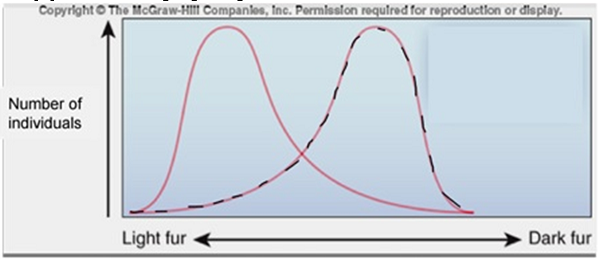A population of voles (small mammals) live in a shady forest. Originally, the voles are a light tan color, but then a dark brown coloration arises by a new mutation. The darker voles are harder for predators to see in the leaf litter, thus they are less susceptible to predation. After 10 generations the majority of voles in the population are the dark brown color. In the figure below, the solid red line represents the number of light colored individuals before the mutation and the black dashed line represents the number of dark brown individuals after 10 generations. What type of natural selection are the population of voles going through?

A. Directional selection.
B. Stabilizing selection.
C. Diversifying selection (disruptive selection).
D. Balancing selection.
E. Negative frequency-dependent selection.
A. Directional selection.
You might also like to view...
Which of the following hormones increases blood pressure by directly stimulating the distal convoluted tubule and collecting ducts to take up more water and salts?
A. aldosterone B. angiotensin II C. antiotensin I D. renin E. antidiuretic hormone
Which of the following would contain genetic material that is 100% identical?
A. Homologous chromosomes B. Sister chromatids C. X and Y chromosomes D. All of the answers are identical
If you were cast up on a desert island with no
fresh water to drink, the level of which of the following would rise in your bloodstream in an effort to conserve water?
a. erythropoietin b. oxytocin c. insulin d. antidiuretic hormone e. glucose
Discuss the dangers of placing too much emphasis on the genetic basis of personality and behavior. What will be an ideal response?